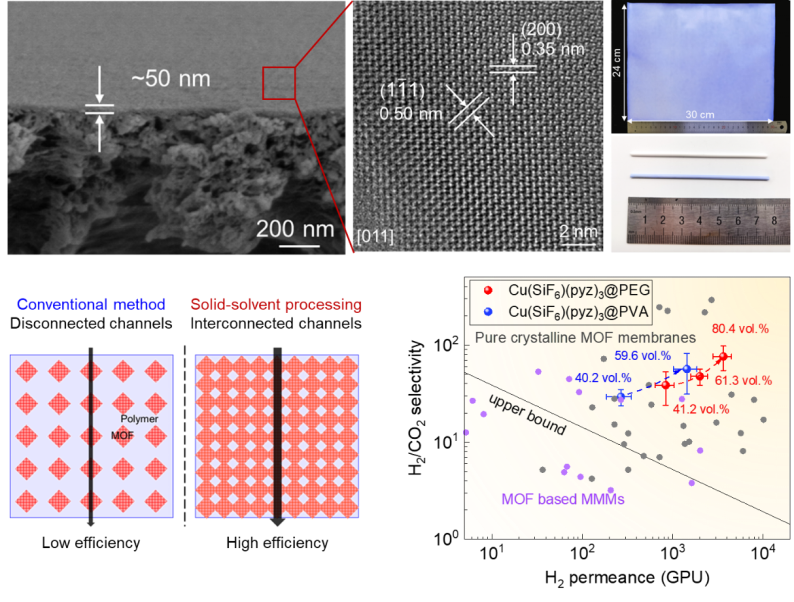On September 21st, Science showcased the research paper titled "Solid-solvent processing of ultrathin, highly loaded mixed-matrix membrane for gas separation" by Professor Wanqin JIN's group of Nanjing Tech University. Dr. Guining CHEN, a postdoctoral researcher, serves as the first author, with Professor Gongping LIU and Professor Wanqin JIN as co-corresponding authors. Collaborative efforts also included scholars from King Abdullah University of Science and Technology in Saudi Arabia and the Suzhou Laboratory. This groundbreaking achievement marks another significant advancement in the field of confined mass transfer membranes for JIN's team, following there prior successes with 2D material membranes (Nature, 2017, 550, 380) and metal-organic framework membranes (Nature Materials, 2023, 22, 769)."
In the realms of chemical engineering, energy, and the environment, molecular separation holds paramount importance. Membrane separation, with its low energy consumption and eco-friendly advantages, outshines traditional separation techniques. The integration of high-performance inorganic fillers into polymers to create mixed-matrix membranes (MMMs) holds the promise of shattering the constraints on polymer membrane permeability and selectivity, positioning itself at the forefront of international research in recent years.
The team led by Professor Wanqin JIN stands as one of the pioneers in global MMM research. They have achieved a series of milestones in interface regulation, channel construction, and mass transfer mechanisms. As early as 2011, the team proposed a filler surface grafting/coating strategy, producing highly dispersed zeolite molecular sieve MMMs (Chem. Eng. J., 2011, 174, 495; US Patent US8809420 B2). Following this, in 2015, they introduced a polymer-induced assembly method, creating two-dimensional material MMMs with interlayer sieving channels (Angew. Chem. Int. Ed., 2015, 54, 578; Chinese Patent ZL201410526519.3). This work was hailed by Professor Elimelech of Yale University, a member of the National Academy of Engineering, as one of the two major pathways breaking the permeability-selectivity constraint in membranes, as featured in Science.
Based on years of accumulated research and a profound understanding of critical scientific issues, they recently introduced the "solid-solvent processing" for fabricating MMMs. This technique reduces the thickness of existing membranes from micrometers to nanometers and increases the filler loading by 2 to 4 times, achieving an order-of-magnitude improvement in membrane permeability and selectivity. As depicted in Figure 1, using a polymer as the solid solvent, precursor of the filler (metal salt) is dissolved and coated onto the surface of a porous support to form an ultra-thin film layer. Subsequently, the precursor in the polymer is transformed in situ into the filler (metal salt reacts with organic ligands to form a metal-organic framework (MOF)). Distinguished from the complex process of preparing MMMs through "synthesis of filler - dispersion of filler - mixing of filler and polymer," this method only requires the dissolution of high-content precursor in the polymer to achieve uniform ultra-thin doping with high-content filler. Simultaneously, it constructs a novel MMM structure with the filler as the main phase, creating high permeating channels for molecules.

Figure 1. Schematic of the membrane preparation process.
Experimental results demonstrate, as shown in Figure 2, that the MMM prepared by the "solid-solvent processing" has a thickness of only 50 nm, with filler loading exceeding 80%. Based on the ultra-thin membrane layer and the permeating sieving channels filled with the filler, this MMM exhibits outstanding separation performance akin to pure MOF membrane. Its hydrogen/carbon dioxide separation performance surpasses existing polymer membranes and MMMs by 1-2 orders of magnitude, holding potential in applications such as pre-combustion carbon capture, and is poised to aid in the realization of China's dual-carbon strategic goals. Furthermore, the "solid-solvent processing" relies primarily on polymer membrane processing technology, making it easy to scale up production into ultra-thin flat and hollow fiber-type MMMs. It is applicable to various types of fillers and polymer matrices, demonstrating excellent prospects for large-scale production and material universality. It has been granted a Chinese patent (ZL202210222277.3) and a US patent application (US 18/165235). Currently, the team is conducting research on the scale-up production and application technology of MMMs under the support of the National Key Research and Development Program (2022YFB3804800)."

Figure 2. Membrane structure and separation performance.
"This work fundamentally resolves two long-standing technical challenges in the development of MMMs: filler agglomeration and interface defects. It also provides experimental evidence for the feasibility of ultra-thin, highly loaded MMMs for the first time. Furthermore, it offers new perspectives and theoretical foundations for the development of ultra-thin separation membranes and functional coatings based on nanomaterials.
This research has received funding from key national research and development projects, the National Natural Science Foundation, collaborative innovation centers, and has been strongly supported by the State Key Laboratory of Chemical Engineering, the School of Chemical Engineering at Nanjing Tech University, and the Energy and Environmental Materials Department at the Suzhou Laboratory."
Link: https://doi.org/10.1126/science.adi1545